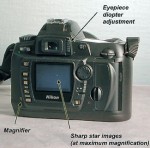 Have you ever looked through the eyepiece of your DSLR and thought things just weren’t in focus? Or perhaps you wear glasses and find they get in the way, but you need them to frame your shot properly?
Have you ever looked through the eyepiece of your DSLR and thought things just weren’t in focus? Or perhaps you wear glasses and find they get in the way, but you need them to frame your shot properly?
Did you know there is a little dial called the Diopter Adjustment? This may seem basic for those of you already in the know, yet I have received enough questions and pointed out this miracle adjustment to enough people that I’m hoping this post will help just one of you out there enjoy your camera all the more.
Most brands of DLSRs have a dial of some type to the right of the eyepiece. Nikon’s can be big or small and obvious, Canon’s is more discrete (especially with the eyepiece cup mounted). They function the same on both systems. In essence the diopter adjustment knob works as a lens switching from near to far focus. It does not effect the focus circuitry of the camera as it is after the auto-focus mechanism. It only effects how your eye picks up the image.
It works just like the device an eye doctor puts in front of you when checking your vision. That device has lenses of various concave and convex curves to adjust for nearsightedness and farsightedness. They adjust for an eye that can’t focus at a reasonable distance, such as for close objects like reading this text. That little dial on a camera typically has an adjustment range of -3 to +3, with 0 being nominal 20/20 vision, more or less.
If your eye-site is anything less than average (essentially what 20/20 is telling you), this knob will be your best friend to help shoot better photos, especially if you attempt to use manual focus. To set the diopter correctly, you will need to set your camera on something solid, like a tripod, and point it at something flat with enough texture to be easily seen. Press your shutter release halfway down to force your camera with auto-focus.
This test relies on the idea that your camera focuses properly, obviously. Without moving the camera, turn the diopter control until (with or without glasses) the image is in focus to your eye. That is all there is to it!
I know it seems simple, but sometimes even a small adjustment for those who think they have average eye site can be helpful.